Whether you choose Hurtigruten or Havila, the timetable for the Norwegian coastal route is the same. Here's what you need to know about the full voyage including all ports of call.
Imagine watching the ever-changing Norwegian coastline go by from the comfort of a lounge chair. A few times a day, you call into ports to drop off local passengers and collect cargo. Some are bustling cities, others tiny communities.
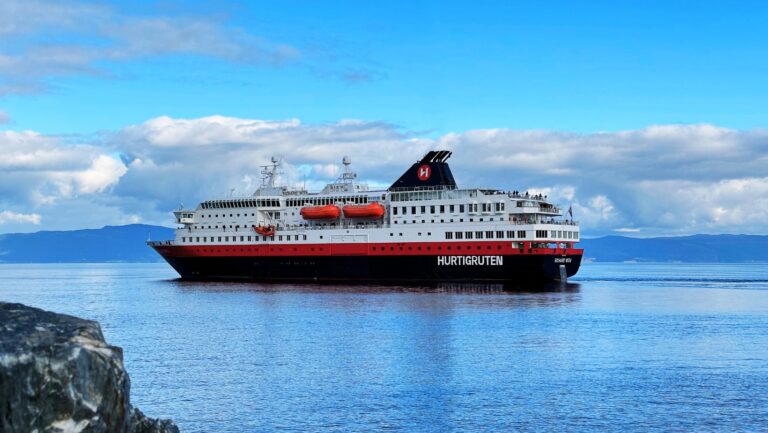
In the evening, you enjoy a top class dinner and relax in the bar chatting to people from across Northern Europe, and farther afield. In the morning, you get up and do it all over again. Welcome to the Norwegian coastal voyage.
An Introduction to Norway’s Coastal Ferry
Norway's coastal voyage is one of the top tourist experiences in Norway, but many people misunderstand what it is.
Presently operated by both Hurtigruten and Havila, Norway's coastal cruise has a 130-year history as a regularly scheduled ferry service along the Norwegian coastline. In recent decades, the route has been Bergen-Kirkenes-Bergen.
So while it is very much a working ferry that carries local passengers and cargo, it is also possible to join for longer voyages. Passengers that do so receive a more cruise-like experience with inclusive restaurant meals, enrichment talks, and optional excursions in many ports.
Hurtigruten Coastal Cruise: Get the latest fares and availability for your trip.
The biggest difference is that many Norwegian passengers use the service as a local ferry, and as such, there are many, many ports of call.
Whereas on a typical Norway cruise there might be three or four ports in a seven-day itinerary, the Norwegian coastal route calls at 34 ports across its 11-night/12-day loop.
Generally, port stops are for less than one hour, but in bigger cities the vessels stay for longer, allowing roundtrip passengers a chance to explore.
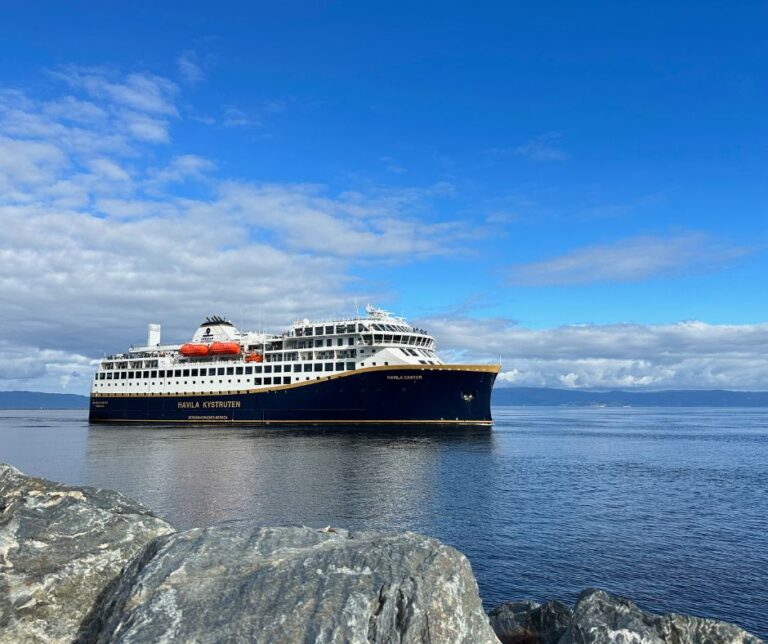
Another perk is that some ports visited at night going northbound are visited by day southbound. Some of the smaller ports are only visited in one direction.
A Port-by-Port Guide
I've taken the ferry service many times, including one full roundtrip back in 2019. That was on the Hurtigruten MS Vesterålen, just prior to its most recent refurbishment. In early 2024, I'm planning my second full voyage. Watch this space!
If you're planning a trip, here's what you can expect day-by-day and from each of the 34 ports.
Note: The exact timetable can vary seasonally, and for operational reasons. Be sure to check the information you receive when booking for precise timings.
Note that I use the term “cruise passengers” in this article to refer to people taking a longer voyage and/or the full roundtrip, as opposed to local ferry passengers.
Day 1: Departure From Bergen
In most ports, passengers board the vessels just like a regular ferry. It works a bit differently in Bergen, where the experience is more cruise-like, especially for those on a longer voyage or the full roundtrip.
The ferry departs from Bergen's coastal ferry terminal at 8.30pm every day. Cruise passengers can check in from as early as 4pm in the terminal building. Luggage is taken away to be delivered to your cabin later, and there’s a comfortable waiting area to use before boarding.
Safety drills are held in the terminal building before boarding. Depending on the time you board, you cabin may or may not be available. If that’s the case, you can wait in one of the public lounges until an announcement is made.
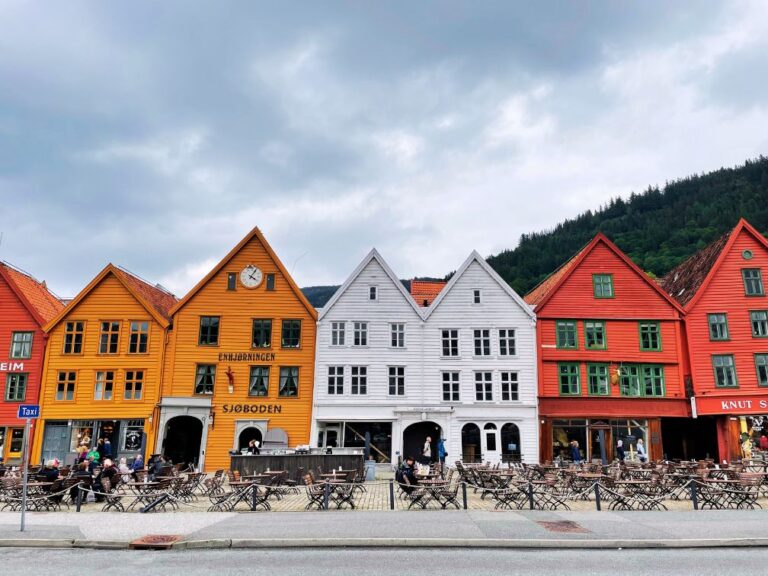
On the opening night, the restaurant is open for a welcome dinner. After settling in and filling their bellies, most people head out on to the open decks at 8.30pm to watch the sailaway.
Bergen
For those taking the roundtrip, it would be a mistake to head straight to the ferry. Bergen is one of the best city for tourists on the entire route.
Hurtigruten Coastal Cruise: Get the latest fares and availability for your trip.
There are so many things to do in Bergen that we couldn't possibly list them all here. The UNESCO World Heritage Site of Bryggen is a must-do, and the art museums of KODE are worth a look for those interested.
Day 2: The Voyage Begins
By the time most people awake on the first morning of the trip, there will have already been a few ports of call! Such is the life of a working ferry. Day two is defined by Ålesund, and it's one of the days that varies significantly depending on the season.
As the route passes Norway's western cape, one of the more exposed parts of the route, you should expect some bumpy seas on this part of the voyage.
Florø
In the middle of the night, the ferry makes its first stop at the small island town of Florø.
Måløy
At approximately 5.15am, the ferry arrives in the busy fishing port of Måløy, another island town. A quirk of Måløy is that the majority of streets are numbered rather than named, as is the norm in the rest of Norway.
Torvik
The first port the majority of roundtrip passengers will see is Torvik, as the ferry arrives for the briefest of stops at about 8.20am. Rich in fishing and maritime history, Torvik is of special interest to those on Havila vessels as the town is the home of the company.
Ålesund
The first major stop on the route is the beautiful coastal city of Ålesund. In the winter and spring, the ferry stays in port for the majority of the day, allowing roundtrip passengers the chance for a wide variety of interesting excursions.
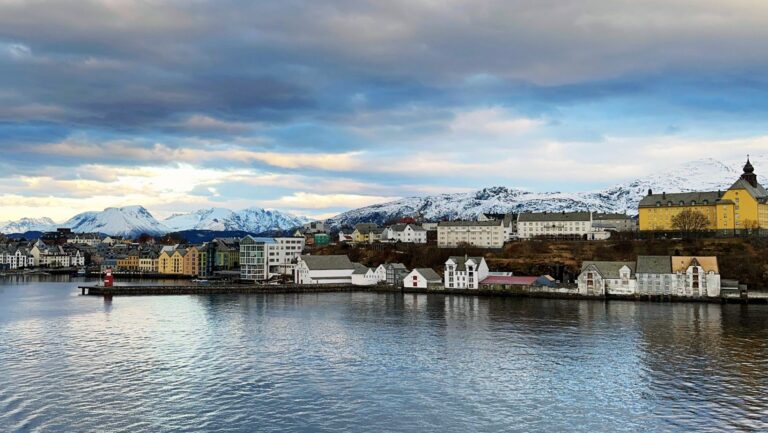
For those choosing to explore Ålesund independently, simply walking around the downtown area is the best way to start. The story of Ålesund's fire and resulting reconstruction is a fascinating one.
In the summer, the ferry makes a brief stop in Ålesund before continuing on to the Geirangerfjord and returning to Ålesund in the evening. In the autumn, the ferry goes to the Hjørundfjord during the day. Both trips are part of the journey, not excursions.
Molde
At about 10.30pm the ferry calls into Molde. While the town isn't particularly attractive, the setting around it is. So, if you're still awake after a busy first full day onboard, it's well worth staying up to watch the sail-in towards Molde. The ferry stays docked for about 30 minutes.
Day 3: A Historic City Break
Much of day 3 is spent at sea. So, it's well worth spending the time docked in Trondheim to get out and about and explore one of Norway's most fascinating cities.
Kristiansund
In the middle of the night, the ferry makes a brief call at Kristiansund. Roundtrip guests have a chance to better see Kristiansund on the southern leg.
Trondheim
Norway's former capital is the undoubted highlight of day three, with a three-hour stop in the morning. Many independent travellers head for Nidaros Cathedral and the picturesque Bakklandet neighbourhood.
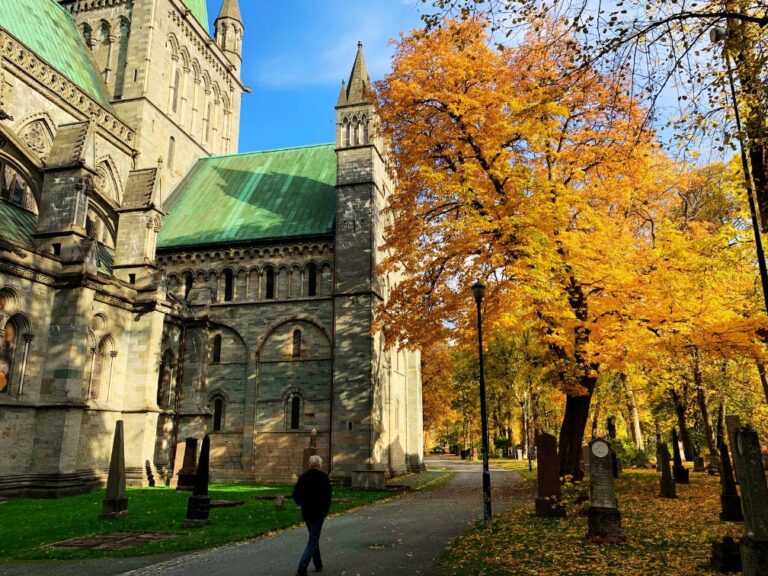
Just bear in mind the port is a reasonable walk from the main downtown attractions, so be sure to leave enough time to get back to the ferry!
Rørvik
A late evening stop at Rørvik is the only other stop on the third day of the trip. Although the stop is brief, Rørvik is located on a busy coastal strait. This makes the approach a good time to be out on deck for a post-dinner stroll.
Day 4: Into the Arctic
The fourth day of the voyage is packed with port calls and coastal scenery, making it the perfect day to snag your favourite window seat or outdoor deckchair. The Lofoten scenery in the late afternoon and evening is especially scenic.
There are several early morning calls along a beautiful stretch of the Helgeland coastline. For those on the coastal voyage, you'll be able to appreciate it fully during the daytime on the southbound leg.
Brønnøysund
In the middle of the night, the ferry makes a brief call at Brønnøysund.
Sandnessjøen
In the very early hours of the morning, the ferry makes a brief call at Sandnessjøen.
Nesna
At about 6am, the ferry makes a brief call at Nesna.
Ørnes
Shortly after crossing the Arctic Circle, the ferry makes a mid-morning stop at Ørnes. With less than 2,000 residents in the town, and mountain peaks and small islands all around, this is a picturesque location whatever the season.
Bodø
In the early afternoon, the ferry stops in Bodø for a little over two hours. This allows cruise passengers to take a trip to the Saltstraumen maelstrom by RIB boat, or independently explore the town centre of Bodø. In 2024, Bodø becomes a European Capital of Culture.
Stamsund
After a few hours of sailing towards the imposing ‘Lofoten wall‘, the ferry arrives in Lofoten at the scenic fishing village of Stamsund. Some excursions leave here and rejoin the ferry at Svolvær.
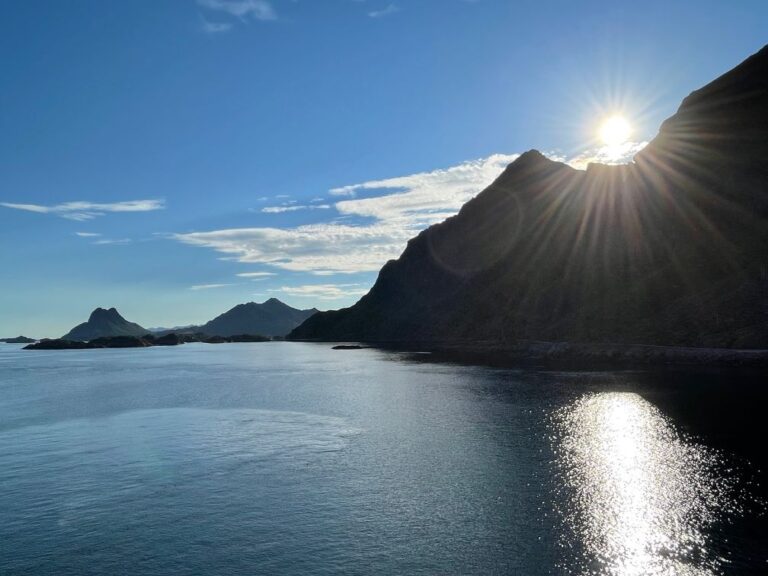
Svolvær
After a beautiful sail alongside the Lofoten mountains, the ferry reaches Lofoten's main town, Svolvær. I highly recommend a post-dinner walk around the town as the setting is a truly spectacular one. Roundtrip passengers can opt out as there's a longer port call earlier in the evening on the return leg.
Day 5: Tromsø
More Arctic scenery is in store on day 5 as the ferry turns east and sails along Norway's northern coastline. It dips in and out of straits and sounds, between islands, offering protection from the worst weather and sea conditions.
Stokmarknes
In the middle of the night, the ferry makes a brief call at Stokmarknes.
Sortland
In the middle of the night, the ferry makes a brief call at Sortland.
Risøyhamn
In the very early hours of the morning, the ferry makes a brief call at Risøyhamn.
Harstad
If you enjoy an early morning walk, Harstad could be a good option for you. The ferry calls at this historic Arctic port for just 35 minutes, but it's enough time to stretch your legs around the public square and along the waterfront.
Finnsnes
In the late morning, Finnsnes is the gateway to the beauty of Senja island. The Gisund Bridge is a human-built landmark of the area. The 30-minute port call once again offers a chance to stretch your legs.
Tromsø
A highlight of the whole voyage for many, Tromsø is the largest city in Northern Norway and as such, functions as a hub of Arctic culture.
The four-hour afternoon port call offers visitors just enough time for a tour of the city. There's plenty of exciting things to do in Tromsø, so decisions will have to be made.
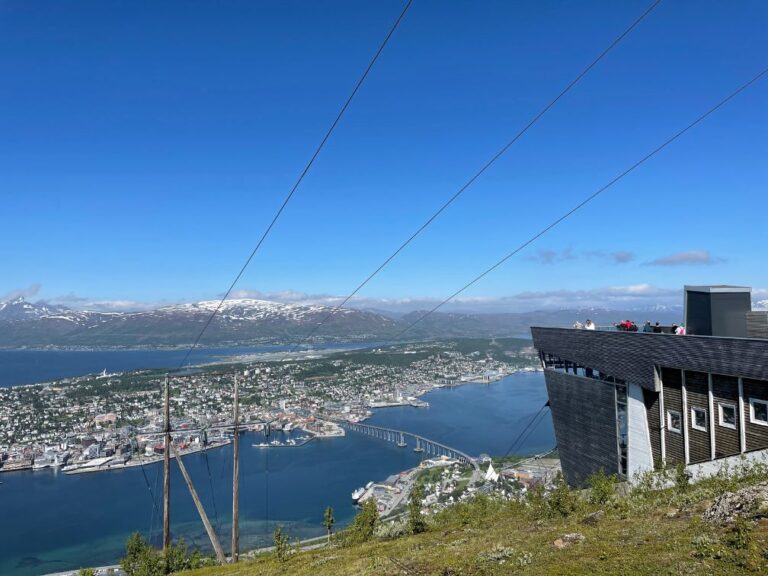
On a clear day, I recommend a trip on the cable car, which you can do via an excursion or independently.
Skjervøy
The stunning Lyngen Alps are among the wonderful scenery you'll be able to appreciate during or after dinner on day five.
The waters around the island town Skjervøy are well-known for orcas and humpback whales, depending on the time of year. Your onboard expedition team will be able to tell you if there is a chance of seeing one of these magnificent creatures.
Day 6: Remote Northern Norway
For me, day six is the most eye-opening day on the trip. Because you've already passed Tromsø, the best known city in the north, it might seem you're almost at the turnaround point.
Yet the multiple port calls and tiny communities you'll visit throughout day six highlight just how vast and remote this part of Norway truly is.
Øksfjord
In the middle of the night, the ferry makes a brief call at Øksfjord.
Hammerfest
In the early hours of the morning, the ferry makes a brief call at Hammerfest.
Havøysund
A busy fishing port on an Arctic island, Havøysund is a small but vibrant town, typical of the remote communities that rely on the coastal ferry.
The short port call here means there's no time for a walk, but the town, sound, and wild nature of the surroundings make for a beautiful backdrop for breakfast or a morning walk on deck.
Honningsvåg
The northernmost port on the journey, the ferry makes a 3.5-hour stop at this small town primarily to allow cruise passengers to visit the North Cape. Organised excursions and independent options are both available to visit the landmark location.
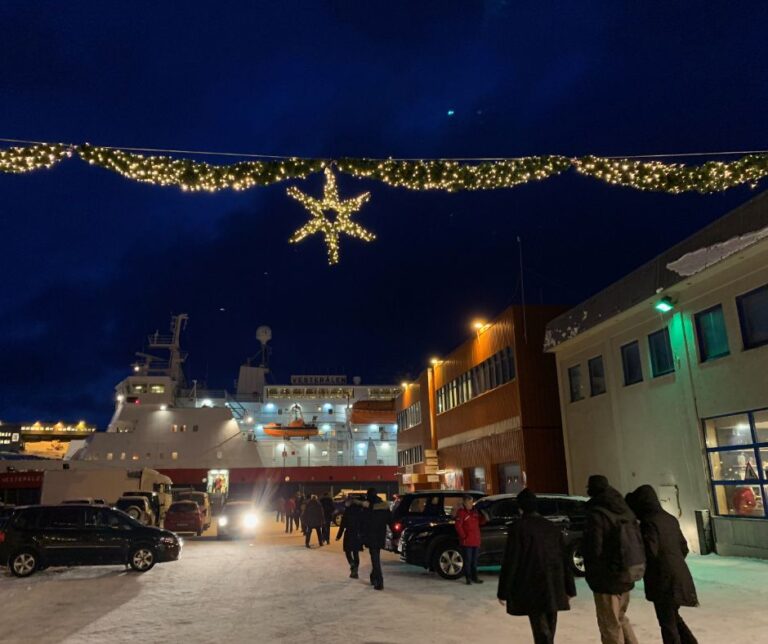
For those who have been to the North Cape before or just aren't interested, the relatively long port call gives plenty of time to explore the highlights of Honningsvåg.
Kjøllefjord
In the late afternoon, the ferry calls at Kjøllefjord, an important meeting place and trading point for hundreds of years. At just 20 minutes, the port call is too short to explore the settlement, but the views entering and leaving the fjord are lovely.
Mehamn
Bumpy seas are possible in and around Mehamn as you sail along the exposed northern coastline. Originally a whaling settlement, Mehamn is today a fishing village home to around 700 people. A short stop is made at Mehamn around dinnertime.
Berlevåg
It's one of the most remote places on the route, yet almost 1,000 people continue to choose to live here. The 10-minute port call at 10pm isn't long enough to find out why, but you'll be able to appreciate Berlevåg and its stark surroundings from the deck.
Day 7: Turnaround Day
There are more and longer stops on the northbound leg, so the turnaround day is actually a little over halfway through the 12-day itinerary.
Båtsfjord
At midnight, the ferry arrives in the small yet busy fishing port of Båtsfjord, where it spends half-an-hour. Although the small town of 2,000 people does have an airport, it still relies on the coastal ferry because of its remote location. The ferry only calls here on its northbound journey.
Vardø
In the middle of the night, the ferry visits Vardø for the only time on the voyage. The island town Vardø is the easternmost point on the journey, and the functional nature of the town's architecture tells the story of the challenges of living in such an exposed place.
Vadsø
At around 7am, the ferry arrives in Vadsø for another short call. As another place close to the turnaround port, Vadsø is only a stop on the northbound leg. The landscapes here in the Varanger region are barren, but the birdlife is plentiful.
Kirkenes
Well-known as the turnaround point for the ferry, this Norwegian town with Russian street signs is a true cultural melting pot. Many passengers will leave and join the ferry here.
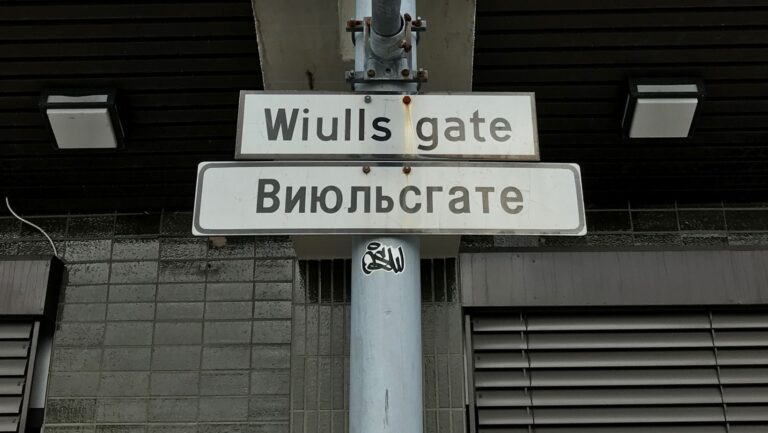
For roundtrip passengers, it's well worth a stroll around the town just to take in this unique society. The ferry should leave Kirkenes to start its southbound voyage around lunchtime at 12.30.
Berlevåg
For guests on the roundtrip voyage, Berlevåg is the first port you will visit for the second time. The late evening port call is just 10 minutes, but it's also a port where the northbound and southbound vessels meet.
Day 8: More of Northern Norway
If you think you saw Northern Norway on the northbound leg, think again! Day 8 allows roundtrip passengers to see some places that were visited overnight on the way up.
Mehamn
In the middle of the night, the ferry makes a brief call at Mehamn for the second time on the voyage.
Kjøllefjord
In the middle of the night, the ferry makes a brief call at Kjøllefjord for the second time on the voyage.
Honningsvåg
In the early hours of the morning, the ferry stops at Honningsvåg for the second time on the voyage, but this time just for 15 minutes.
Havøysund
At around 8am, the ferry makes a brief call at Havøysund for the second time on the voyage.
Hammerfest
At around 11am, the ferry makes calls into Hammerfest. Unlike the brief overnight call on the northbound journey, this southbound port call lasts for almost two hours.
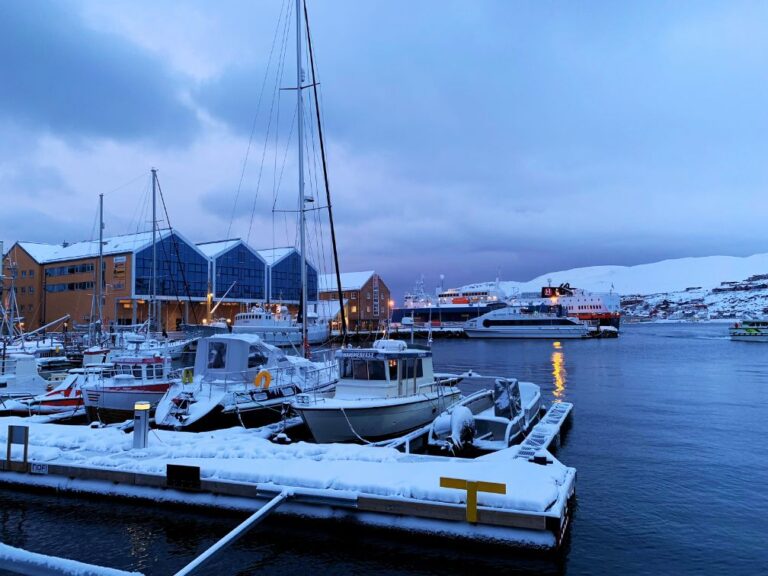
This is enough time to explore the compact downtown and redeveloped waterfront of this important northern city. The Museum of Reconstruction is a must-visit to better understand the World War II history in this part of Norway.
Øksfjord
In the late afternoon, the ferry makes a brief call at Øksfjord for the second time on the voyage. While the short port call isn't long enough to explore, it does give passengers a chance to take in the tiny village of just 500 people with its imposing mountain backdrop from the outside decks.
Skjervøy
At around 7.30pm, the ferry makes a brief call at Skjervøy for the second time on the voyage. It's another opportunity to enjoy the wonderful mountainous setting at dinner, or over a post-dinner drink.
Tromsø
Most late night port calls aren't worth staying up for, but Tromsø is a definite exception. This call from 11.45pm to 1.30am allows guests to experience the midnight sun during the summer months.
The hours immediately before the port call and during the stay in port are also great times to hunt for the northern lights between September and March. Given the late night nature of this port call, make sure you get your Tromsø sightseeing done on the northbound leg.
Day 9: Vesterålen and Lofoten
The highlight for guests only taking the southbound leg is likely going to be sailing through the Lofoten Islands on day 9. Photographers should prepare to spend much of the day and evening out on deck.
Finnsnes
In the very early hours of the morning, the ferry makes a brief call at Finnsnes for the second time on the voyage.
Harstad
At around 8am, the ferry makes a 30-minute call at Harstad for the second time on the voyage. As with the northbound voyage, it's enough time for a very quick walk around the town centre. A popular excursion introducing the historic culture and beautiful landscapes of the Vesterålen region leaves Harstad by bus, rejoining the ferry later on in Sortland.
Risøyhamn
Unlike the overnight call on the northbound leg, this port call visits Risøyhamn in the late morning. The 15-minute stop isn't long enough to leave the ship, but from the outside decks you'll get a terrific perspective on this scenic community. Just a few hundred people live in this small settlement, and you'll quickly understand why.
Sortland
Another port call that's visited overnight on the northbound leg but in the daytime going south is Sortland. The sizeable town is fairly ordinary aside from one curious fact–many of the buildings are painted blue. You'll be able to see some of these from the ship.
Stokmarknes
At about 2.15pm, the ferry pulls in to the birthplace of the coastal route. Stokmarknes is home to the Hurtigruten museum, a great way to dive into the history of the very route you're sailing. The one-hour port call is just about enough to see the museum.
Svolvær
A two-hour port call in the early evening is enough time for a proper tour of Svolvær, the biggest town on Lofoten. Just because you're in a town doesn't mean you'll miss out on the spectacular scenery either.
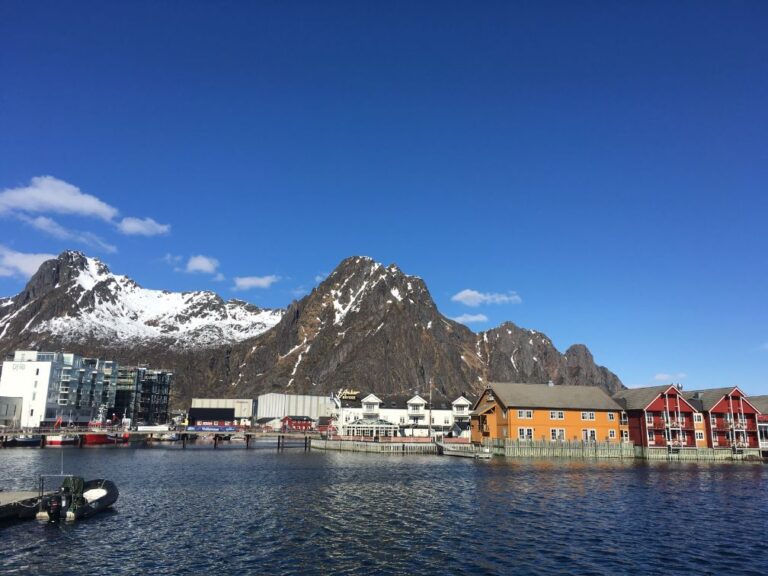
Highlights include the Magic Ice bar, a comprehensive Second World War Museum, and a tour of the local brewery. For the latter you'll need to book on an excursion with either Hurtigruten or Havila.
Stamsund
The evening sailing between Svolvær and Stamsund provides some of the journey's best scenery in the lengthy days of the summer. In the late evening, the short 15-minute port call in Stamsund marks the goodbye to the Lofoten Islands.
Day 10: Helgeland Coastline
Much of the best of the Helgeland coastline between Trondheim and Bodø is covered overnight on the northbound leg. So, heading back south, it's time to enjoy one of Norway's most underrated stretches of coastline.
Bodø
A one-hour port call at Bodø takes place in the middle of the night.
Ørnes
Early risers may catch the voyage's second call at Ørnes. It marks the starting point of a wonderful morning of sailing through a picturesque archipelago.
Nesna
About 1,300 people live in the small town of Nesna, which is more vibrant than its small population may suggest. It hosts a small campus of Nord University, and is an important ferry hub to the many nearby island communities. The ferry stops here mid-morning for just 10 minutes, but the beautiful scenery can be appreciated all morning.
Sandnessjøen
As the ferry makes its way south, the communities get bigger. Around midday, the ferry stops for 30 minutes at Sandnessjøen, home to around 6,000 people. Upon leaving Sandnessjøen, secure your spot on the port side of an outdoor deck to take in the famous Seven Sisters mountain range.
Brønnøysund
As Brønnøysund is equidistant between the northernmost and southernmost points of Norway, this port call is in the very middle of the Norwegian coastline. The ferry calls at Brønnøysund for more than two hours, more than enough time for a good walk around this relatively small town home to around 5,000 people.
If you're still looking for some souvenirs or just some supplies, there is a shopping mall a short walk from the ferry port.
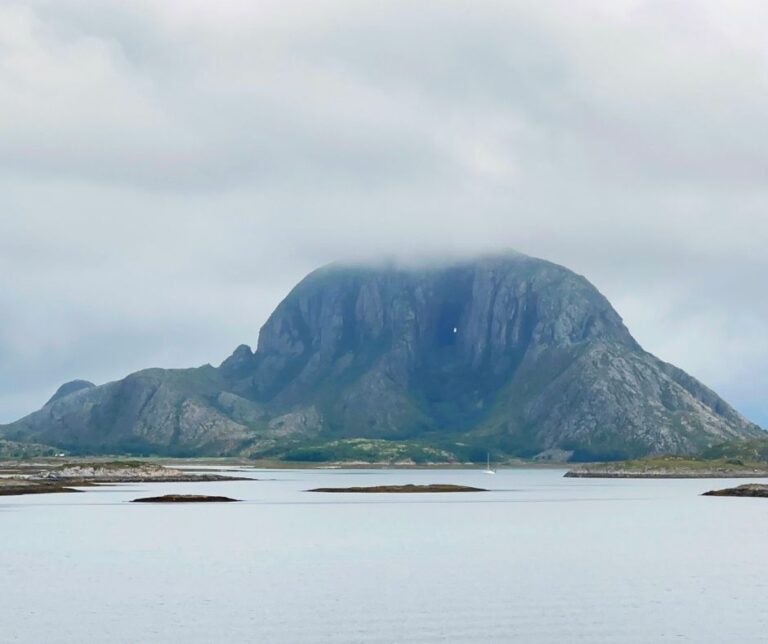
Back on the ship, a highlight of this stretch of coastline is the mountain Torghatten, located just outside Brønnøysund. The ‘mountain with the hole' has a fascinating history and mythology, which you'll learn about on board.
Rørvik
The journey's second call in at Rørvik takes place at around 9pm. Once again it's worthwhile to be out on deck if you're interested in ships as the Rørvik strait is busy. You may also see the northbound ferry.
Day 11: Trondheim to Ålesund
Although the voyage is nearly over, there's still plenty to see in the evening of the eleventh day. During the daytime, you'll enjoy one of the longest stretches of time at sea.
Trondheim
Early risers will get another chance to visit Trondheim as the ferry visits from 6.30am to 9.30am. Upon leaving Trondheim, you'll pass the northbound ferry as it arrives.
Kristiansund
Seven hours after leaving Trondheim, the ferry arrives in Kristiansund. The 4.30pm arrival and one-hour stay make it possible to enjoy a stroll along Kristiansand's waterfront on this southbound leg. The town, built over several islands, is home to one of the world's oldest continuous running public transport systems, the Sundbåten passenger ferry.
Molde
Although a little earlier than the northbound port call, the ferry's southbound arrival at Molde is still quite late at 9.15pm. If the ship is on time then there's the opportunity for a short walk around Molde's compact central area. The Molde to Ålesund stretch is popular with local passengers.
Day 12: The Return to Bergen
When waking from your eleventh night onboard, it's time to say goodbye to your cabin and enjoy your final few hours onboard. There aren't any port stops where you can leave the ship, so it's simply a case of enjoying your final few hours of relaxation and scenic views, not to mention the farewell lunch.
Ålesund
Just after midnight, the ferry arrives in Ålesund of the second time on the voyage. Unlike the northbound leg where it stays in Ålesund for most of the day, the southbound call is just 45 minutes long.
Torvik
In the middle of the night, the ferry makes its second call at Torvik, for just 10 minutes.
Måløy
In the early hours of the morning, the ferry makes its second call at Måløy, for just 15 minutes.
Florø
It's worth getting up for the 8.15am arrival at Florø, as it's the last port call before the end of the line. However, at just 15 minutes, there's no time for a look around. Norway's westernmost town, Florø is known for its fishing and as a supply base for offshore industries.
Bergen
If the ferry is running to schedule, it should arrive back into Bergen at 2.45pm. Many roundtrip passengers will have bus transport booked to the airport. If you're travelling independently, I suggest booking a hotel and travelling home the following day, to give you another chance to explore Norway's second biggest city.
Hurtigruten Coastal Cruise: Get the latest fares and availability for your trip.
So, whether you like big, bustling cities, or small, remote communities, there really is something for you on the Norwegian coastal ferry. Let me know what port is your favourite in the comments below.


can I get on the boat in boda and take it to tromso? how long of trip is it ? is there food onboard and can i get a cabin? what is the cost in early june Thankyou
Yes you can go between any two ports. I suggest you look at the websites of both Hurtigruten and Havila for prices.